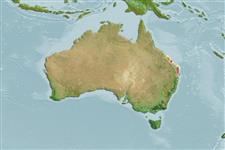>
Lophiiformes (Anglerfishes) >
Histiophrynidae (Starfingered frogfishes)
Etymology: Histiophryne: Greek, istion, istos = sail + Greek, phryne = toad (Ref. 45335); maggiewalker: Named for Maggie Walker for her service and dedication to science and education at the University of Washington and The Burke Museum of Natural History and Culture (Ref. 87287).
Environment: milieu / climate zone / depth range / distribution range
Écologie
marin démersal; profondeur 7 - 12 m (Ref. 87287). Tropical
Pacifique: Australia.
Taille / Poids / Âge
Maturity: Lm ? range ? - ? cm
Max length : 5.5 cm SL mâle / non sexé; (Ref. 87287); 6.0 cm SL (female)
Description synthétique
Morphologie | Morphométrie
Rayons mous dorsaux (Total): 15; Rayons mous anaux: 8; Vertèbres: 21 - 22. A frogfish of the lophiiform family Antennariidae, genus Histiophryne, unique in having a relatively long illicium and esca, the latter expanded distally, its shape more or less rectangular with rounded edges, and genetic divergence in the nuclear recombination activation gene-2 (RAG2) and cytochrome oxidase-I (COI) genes (Ref. 87287).
Body short and deep, somewhat compressed laterally, vertebral column distinctly sigmoid in shape; head large, its length approximately 29−39% standard length (SL); mouth small(relative to other antennariid taxa), opening strongly oblique to nearly vertical. Jaws bearing 2–4 irregular rows of small villiform teeth; similar teeth present on vomer and palatine. Eye diameter 4.5–4.9% and 8.8–9.1% SL for adults (four specimens) and juveniles (two specimens), respectively. Spinous dorsal fin consisting of three widely spaced spines, anteriormost spine (illicium) relatively long (2.5–4.7% SL); second and third dorsal-fin spines laid back and bound down to surface of head by thick skin; esca relatively long (4.1–6.4% SL), more or less rectangular with rounded edges. Pectoral-fin lobe elongate, leg-like, attached to side of body by loose skin for most of its length. Opercular opening restricted to a small, elongate, tube-like opening situated immediately posteroventral to base of pectoral fin. Caudal peduncle absent, thick fleshy posteriormost margin of soft-dorsal and anal fins extending posteriorly well beyond base of caudal fin, connecting to outermost caudal-fin rays. Skin covering head and body everywhere thick, fleshy, and naked, lacking any visible trace of dermal spinules or cutaneous filaments or appendages. Rays of dorsal, anal, pectoral, and pelvic fins all simple; those of caudal fin all bifurcate. Dorsal-fin rays 15; anal-fin rays 8; pectoral-fin rays 8; pelvic fin with 1 spine and 5 rays; caudal-fin rays 9; vertebrae 21–22, including the anteriormost and posteriormost centra fused to the cranium and hypural plate, respectively (Ref. 87287).
Known only from shallow inshore waters. While some frogfishes are notorious for their insatiable appetite, including tendencies to cannibalize one another, it is possible these four were living together peacefully (Ref. 87287).
Life cycle and mating behavior
Maturité | Reproduction | Frai | Œufs | Fécondité | Larves
Arnold, R.J. and T.W. Pietsch, 2011. A new species of frogfish of the genus Histiophryne (Teleostei: Lophiiformes: Antennariidae) from Queensland, Australia. Zootaxa 2925:63-68 (Ref. 87287)
Statut dans la liste rouge de l'IUCN (Ref. 130435)
Menace pour l'homme
Harmless
Utilisations par l'homme
Plus d'informations
Noms communsSynonymesMétabolismePrédateursÉcotoxicologieReproductionMaturitéFraiRassemblement de ponteFéconditéŒufsDéveloppement de l'œuf
Taille/ÂgeCroissanceLongueur-poidsLongueur-longueurFréquences de longueursMorphométrieMorphologieLarvesDynamique des populations larvairesRecrutementAbondanceBRUVS
RéférencesAquacultureProfil d'aquacultureSouchesGénétiqueElectrophoresesHéritabilitéPathologiesTraitementNutrientsMass conversion
CollaborateursImagesStamps, Coins Misc.SonsCiguateraVitesseType de nageSurface branchialeOtolithesCerveauxVision
Outils
Articles particuliers
Télécharger en XML
Sources Internet
Estimates based on models
Preferred temperature (Ref.
123201): 23.6 - 24.3, mean 24 °C (based on 19 cells).
Phylogenetic diversity index (Ref.
82804): PD
50 = 0.5312 [Uniqueness, from 0.5 = low to 2.0 = high].
Bayesian length-weight: a=0.01995 (0.00906 - 0.04395), b=3.01 (2.83 - 3.19), in cm total length, based on all LWR estimates for this body shape (Ref.
93245).
Niveau trophique (Ref.
69278): 3.6 ±0.6 se; based on size and trophs of closest relatives
Résilience (Ref.
120179): Haut, temps minimum de doublement de population inférieur à 15 mois (Fec assumed to be > 10,000).
Fishing Vulnerability (Ref.
59153): Low vulnerability (10 of 100).
